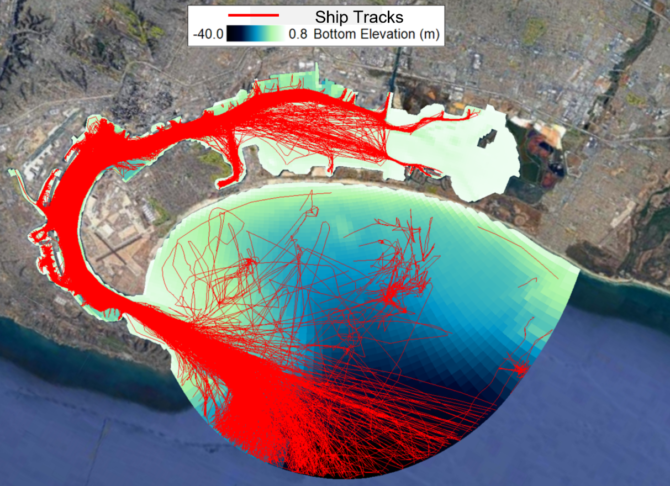Velocity Profile of a Propeller Moving Through a Channel
In our propeller wash (propwash) blog series, we have shared details of the propwash simulation feature that will soon be available in the upcoming version of EEMS. In this post, we would like to demonstrate how the propeller transfers the energy to the water column causing sediment resuspension.
This simple demonstration we present here was conducted on a 3000 meter long channel (refer to Table 1). The sediment bed is 1.4 m deep, and consists of 18% coarse sand, 51% fine sand, and 31% coarse silt. The background ambient velocity of the water is 0.1 m/s moving from east to west. The model simulated two ships moving in opposite directions (refer to Table 2).
Table 1. Details of the EFDC+ Model for Simulating Propwash
| Model Area | 0.60 km² |
| Channel Length and Width | 3000 m x 200m |
| Channel Depth | 10 m |
| Number of Grids | 6000 |
| Number of Grid Rows and Columns | 24 x 304 |
| Water Layers: | 10 |
| Sediment Layers: | 5 |
Table 2. Characteristics of the Ships Simulated by the Model
| Ship Properties | C-Tractor-13 | C-Tractor-14 |
| Gross Tonnage | 300 | 190 |
| Maximum Horsepower | 5800 | 4800 |
| Maximum RPM | 186 | 150 |
| Number of Propellers | 2 | 2 |
| Propeller Diameter (m) | 2.50 | 2.29 |
| Start Position (m) | 2800 | 100 |
| Direction | East to West | West to East |
The animation below shows the simulation of the two ships and their velocity profiles. The animation includes three panels, as described below.
Top Panel – The top panel shows the two-dimensional horizontal view of the channel. In this panel, three layers are visible in the legend. At the top of the legend is a timing bar in hours and minutes in the HH:MM format.
-
- Ship Track (C-Tractor-13) – The larger ship track, as shown by a red line.
- Ship Track (C-Tractor-14) – The smaller ship track, as shown by a purple line.
- Total Suspended Sediments (Depth Averaged in mg/l) – A color ramp of TSS concentrations in the water body.
Middle Panel – This panel shows the vertical profile through the path of the larger ship. The TSS color ramp is the same as before, but it also includes a velocity vector. The size of the velocity vector indicates the magnitude of the water velocity.
Bottom Panel – The bottom panel shows the vertical profile through the path of the smaller ship. The rest of the details are the same as described for the middle panel.
To observe the effect of the propellers on the velocity vectors and the increase in TSS concentrations, you can pause the animation at different times. Changes in TSS concentrations can be observed by the changes in color. The depth-averaged TSS concentrations increase behind the two ships as they move through the water. The TSS concentration behind the larger ship is easily observed to be greater.
The velocity vectors in the bottom two panels show that the direction of water movement is the opposite of each ship’s direction. The velocity vectors also show that the highest velocity occurs at approximately at 4 m depth, which corresponds to the propeller depth. As each ship moves, the increase in water velocity and subsequent increase in shear stress causes scour of the sediment bed and results in increased TSS concentrations. The TSS concentration in the water column increases from top to bottom and is greater for the larger ship than the smaller ship.
As the ship keeps on traveling, the velocity of water in the path traveled behind the ship declines, causing a reduction in shear stress. In turn, the scour stops and sediment begins to settle, causing a reduction in TSS concentrations.
A zoomed in version of the animation was also produced to show the effect of the propeller on the velocity vectors. Near the ship, the velocity vectors reflect the change in velocity direction due to propeller movement. The vertical panels show that the magnitude of the velocity vectors near the larger ship is greater than those near the smaller ship. The velocity of water behind each ship stabilizes after a few hundred meters.
The new Propwash features will be released as testing in EEMS is completed. To be notified of new developments, sign up for the EEMS newsletter.
Want to give EEMS a try with propwash? You can start by downloading EEMS and activating in the free demo mode and the running our demonstration model. To see these features in action, head over to our YouTube page. Also, learn more technical details of the implementation of this feature by reading our whitepaper on propwash.










